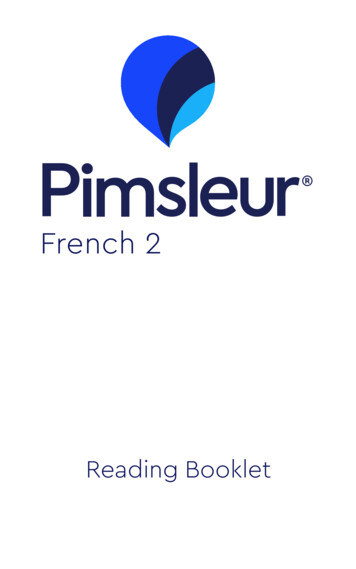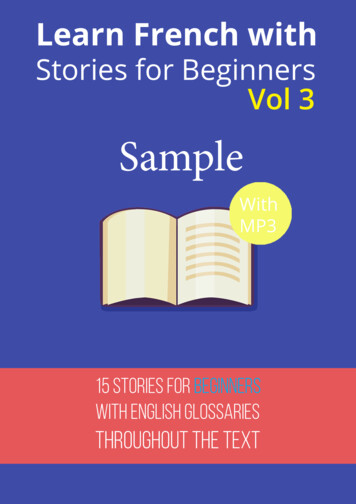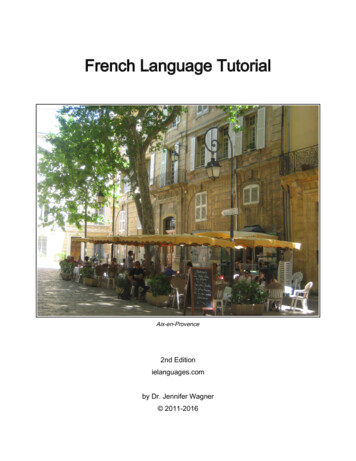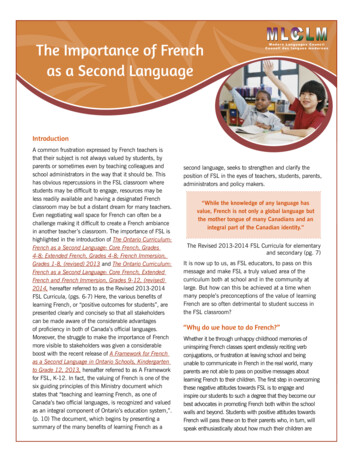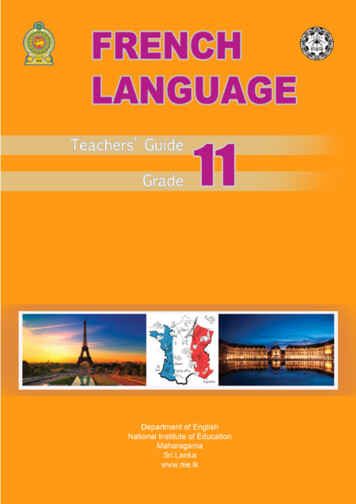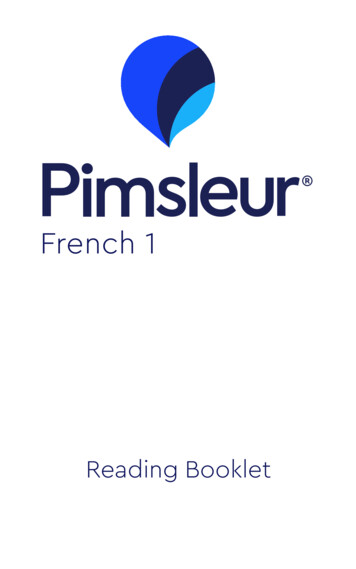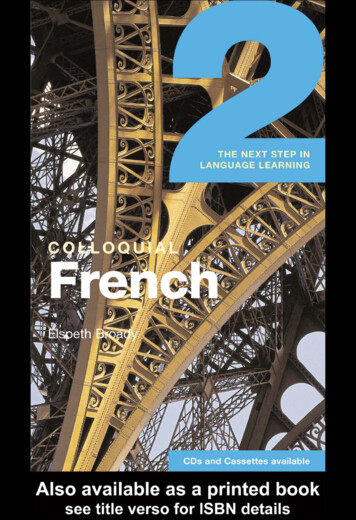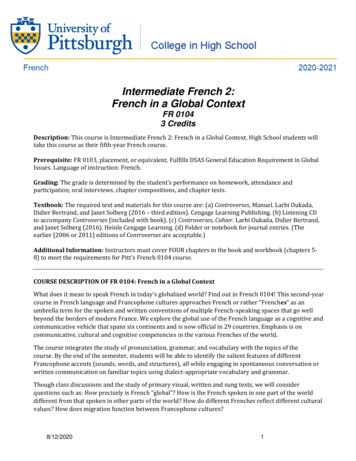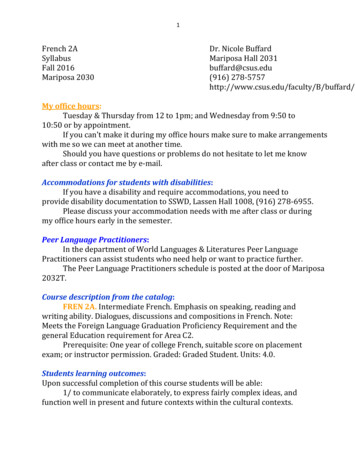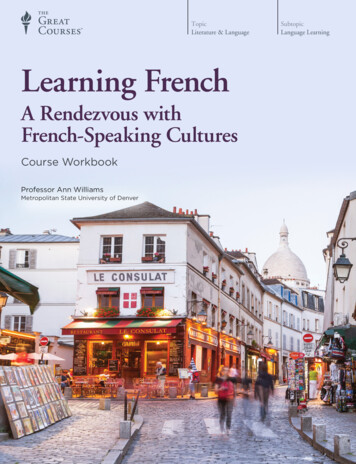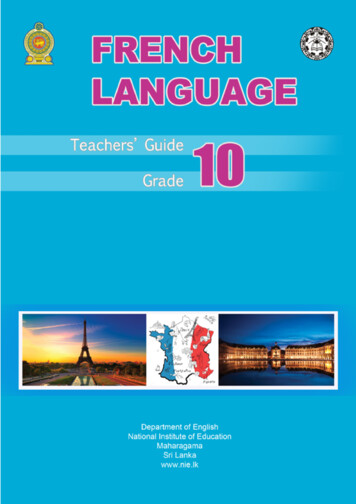
Transcription
French LanguageTeachers’ GuideGrade 10Department of EnglishFaculty of Languages Humanities and Social SciencesNational Institute of EducationMaharagamaSri Lankawww.nie.lk
Teachers’ GuideGrade 10First Edition2016ISBN National Institute of EducationDepartment of EnglishNational Institute of EducationMaharagamaPrinted by :Nanila Publication (Pvt) Ltd,227/30, Nirmana Mawatha, Nawala Road,Nugegoda.ii
Message from the Director GeneralThe first phase of the new competency based curriculum, with 8 years curriculum cycle wasintroduced to secondary education in Sri Lanka in 2007 replacing the existed content basededucation system with basic objective of developing the national level competencies recommendedby the National Education Commission.The second phase of the curriculum cycle to be introduced to grades 7 and 11 starts from 2016. Forthis purpose, National Institute of Education has introduced a rationalization process and developedrationalized syllabi for these grades using research based outcomes and various suggestions made bydifferent stakeholders.In the rationalization process, vertical integration has been used to systematically develop thecompetency levels in all subjects from fundamentals to advanced levels using the bottom upapproach. Horizontal integration is used to minimize the overlapping in the subject content and toreduce the content over loading in the subjects to produce more students friendly and implementablecurricular.A new format has been introduced to the teachers’ guide with the aim of providing the teachers withthe required guidance in the areas of lesson planning, teaching, carrying out activities andmeasurement and evaluation. These guidelines will help the teachers to be more productive andeffective in the classroom.The new teachers’ guides provide freedom to the teachers in selecting quality inputs and additionalactivities to develop the competencies of the students. The new teachers’ guides are not loaded withsubject content that is covered in the recommended textbooks. Therefore, it is essential for theteacher to use the new teachers’ guides simultaneously with the relevant textbooks prepared byEducation Publication Department as reference guides to be more aware of the syllabi.The basic objectives of the rationalized syllabi and the new format of teachers’ guide and newlydeveloped textbooks are to bring a shift from the teacher centered education system into a studentcentered and more activity based education system in order to develop the competencies and skillsof the school leavers and to enable the system to produce suitable human resource to the world ofwork.I would like to take this opportunity to thank the members of Academic Affairs Board and Councilof National Institute of Education and all the resource persons who have immensely contributed indeveloping these new teacher guides.Director GeneralNational Institute of Educationwww.nie.lkinfor@nie.lkiii
ForewordLearning expands into a wider scope. It makes life enormous and extremely simple. The humanbeing is naturally excellent in the skill of learning. A country when human development isconsidered the main focus uses learning as a tool to do away with malpractices identified withintellect and to create a better world through good practices.It is essential to create valuable things for learning and learning methods and facilities within thesphere of education. That is how the curriculum, syllabi, teachers' guides and facilitators join thelearning system.Modern Sri Lanka has possessed a self-directed education system which is a blend of global trendsas well as ancient heritage.It is necessary to maintain the consistency of the objectives of the subject at the national level.However, facilitators are free to modify or adapt learning teaching strategies creatively to achievethe learning outcomes, competency and competency level via the subject content prescribed in thesyllabus. Therefore, this Teachers' Guide has been prepared to promote the teachers' role and tosupport the students as well as the parents.Furthermore, at the end of a lesson, the facilitators of the learning-teaching process along with thestudents should come to a verification of the achievement level on par with ones expected exam by anational level examiner, who evaluates the achievement levels of subjects expected.I sincerelywish to create such a self-progressive, motivational culture in the learning-teaching process.Blended with that verification, this Teachers' Guide would definitely be a canoe or a raft in thisendeavor.Deputy Director GeneralFaculty of Languages, Humanities and Social Sciencesiv
Message of the Commissioner GeneralTeachers are leading personalities among those who render a great service for the progressionof the society. Teachers guide the children to mould their characters.The Educational Publications Department takes measures to print and publish these TeacherInstructional Manuals to facilitate the teachers to carry out the teaching process successfully inaccordance with the new syllabi to be implemented with effect from 2015. I strongly believe that thisTeacher Instructional Manual complied by the National Institute of Education will provide therequired guidance to create a favourable learning environment for the children to learn.This venture will achieve its success on the effort made to utilize the experience acquired byusing this Teacher Instructional Manual in the teaching learning process. I bestow my gratitude onall those who dedicated themselves for this national endeavour.W.D. Padmini NalikaCommissioner General of Educational PublicationsEducational Publications Department,Isusurpaya,Battaramulla.12.05.2016v
Syllabus CommitteeAdvice and Approval :Academic Affairs BoardNational Institute of EducationMaharagamaSubject Coordination:Hashini AbeysenaAssistant Lecturer - Dept. of EnglishNational Institute of Education , MaharagamaDirection:Darshana SamaraweeraDirector , Dept. of EnglishNational Institute of Education, MaharagamaPanel of Writers:Hashini AbeysenaAssistant LecturerDept. of English, National Institute of EducationMaharagamaDr.Subhashini PunchihettiPedagogy ConsultantAlliance Fransaise de ColomboMs.Irosha ChandrasekaraSenior LecturerUniversity of Sri JayawardenapuraMr.Chandeera GunawardhanaLecturer (Probationary)University of KelaniyaMs.Mihiri GunasekaraTeacher of FrenchJanadhipathi Balika VidyalayaRajagiriyaReview committee:Professor Sarath AmunugamaFormer Vice ChancellorUniversity of KelaniyaProfessor Niroshini GunasekaraSenior LecturerDepartment of Modern LanguagesUniversity of Kelaniyavi
Names of the Proof Reading CommitteeMs.U.G.ManoriTeacher of FrenchSamudradevi Balika VidyalayaNugegodaMs.Shyamalie De CostaTeacher of FrenchAnanda CollegeColombo 10Ms.Indeewarie PanditharatnaTeacher of FrenchViharamaha Devi Balika VidyalayaKiribathgodaMs. Kushani Dhananjala KankanamgeTeacher of FrenchSt Paul’s Girls’ SchoolMilagiriyaColombovii
Instructions regarding the Teachers’ GuideThe first competency based French Language syllabus for grade 10 which is to be implemented in2015 has 44 competency levels to be achieved by the students of grade 10. A grade 10 coursematerial consists of the Teachers’ Guide.This Teachers’ Guide consists of the detailed syllabus of grade 10, instructions for lesson planning,instructions for assessment and evaluation and web links given as further reference. They are quiteuseful in understanding and making the teacher familiar with a given competency level. Sampleactivities along with lesson notes that are useful to achieve the expected learning outcomes forrequired competency levels are also given in an integrated manner. Since the number of periods hasbeen notionally included, it is up to the teachers to plan the lessons accordingly based on eachcompetency level and the outcome.Since the educational publication department is not involved in developing text books for thissubject the text books Tricolore Total (1 &2) that are readily available in Sri Lanka , can be used toenhance the teaching Learning process. They are relevant to the new syllabi to a greater extent.Further, their attractive lessons, which motivate the adolescents to master the subject, with an up todate vocabulary and listening activities and a work book, are a convenient source of reference toboth teachers and students in French language pedagogy. In addition to that, J.R.Watson’s (1 and 2),Apprenons le Français (2 and 3), Enchanté (1 ,2,3 and 4), Esprit (1,2, and 3 ) and Dondo can also berecommended to teachers as further references enabling them for selecting activities creativelyaccording to the level and interest of students.Teachers are requested to expose their target language as much as possible so that it helps thestudents to improve their confidence in all 4 language skills; speaking, listening, reading andwriting. However, teachers have the opportunity to be creative and innovative, and prepare theirown lesson plans, so that their students will learn and acquire quickly and use their targetforeign language correctly as and when they are required to do so.Bonne Chance!Project Leaderviii
ContentPage1.Message from the Director General .iii2.Foreword . .iv3.Message of the Commissioner General .v4.Syllabus Committee .vi-vii5.Instructions for using the Teachers’ Guide . viii6.Content . .ix7. Contents of the Syllabus .x- xx8. Instruction for the learning teaching processCompetency 01 . 1-6Competency 02 . 7-8Competency 03 . 9-10Competency 04 .11-17Competency 05 .18-19Competency 06 .20-24Competency 07 .25-27Competency 08 .28-30ix
IntroductionRevised French Language syllabus for grade 10 is presented to the general education system of Sri Lanka based on the followingconsiderations.1. Retaining of the 8 key competencies introduced to the secondary French language curriculum in the year 2015.2. Presenting 44 specific competencies / competency levels identified as relevant and suitable for grade 10. Thedistribution of these competencies is given in the grid below.xCompetencyNo. of C. levels11.1, 1.2,1.3,1.422.1, 2.2, 2.333.1, 3.2, 3.3, 3.444.1, 4.2, 4.3, 4.4, 4.5, 4.6, 4.7, 4.8, 4.955.1, 5.2, 5.366.1, 6.2, 6.3, 6.4, 6.5, 6.6, 6.777.1, 7.2, 7.3, 7.4, 7.588.1, 8.2, 8.3, 8.4, 8.5, 8.6, 8.7, 8.8, 8.93. Identification of learning outcomes expected at the end of the learning teaching process.4. Presentation of basic guidelines and limits of the content for teachers and material developers.In designing the grade 10 syllabus no particular FLT approach was followed, though the CEFR (Common European Framework of LanguageLearning) was specially considered and therefore, teachers, teacher educators and administrators are requested to be innovative and independentto select the best possible methodology to achieve success in teaching and learning French as a foreign language. Moreover, the teachers andmaterial developers are requested to pay heed to achieve national goals and competencies through teaching of French Language in Sri Lanka toensure sustainable development within a peaceful and multilingual world.
National GoalsNation building and the establishment of a Sri Lankan identity through the promotion of national cohesion, national integrity, nationalunity, harmony, and peace, and recognizing cultural diversity in Sri Lanka’s plural society within a concept of respect for humandignity.(ii)Recognizing and conserving the best elements of the nation’s heritage while responding to the challenges of a changing world.(iii)Creating and supporting an environment imbued with the norms of social justice and a democratic way of life that promotes respect forhuman rights, awareness of duties and obligations, and a deep and abiding concern for one another.(iv)Promoting the mental and physical well- being of individuals and a sustainable life style based on respect for human values.(v)Developing creativity, initiative, critical thinking, responsibility, accountability and other positive elements of a well-integrated andbalanced personality.(vi)Human resource development by educating for productive work that enhances the quality of life of the individual and the nation andcontributes to the economic development of Sri Lanka.(vi)Preparing individuals to adapt to and manage change, and to develop capacity to cope with complex and unforeseen situations in arapidly changing world.(vii)Fostering attitudes and skills that will contribute to securing an honorable place in the international community, based on justice,equality and mutual respect.(viii)Fostering attitudes and skills that will contribute to securing an honorable place in the international community, based on justice,equality and mutual respect.xi(i)
Basic competenciesThe following Basic Competencies developed through education will contribute to achieve the above National Goals:(i)Competencies in CommunicationCompetencies in communication are based on four subsets: Literacy, Numeracy, Graphics and IT proficiency.Literacy:Numeracy:Graphics:IT proficiency:xii(ii)Competencies relating to Personality Development (iii)Listen attentively, speak clearly, read for meaning, write accurately and lucidly and communicateideas effectively.Use numbers for things, space and time, count, calculate and measure systematically.Make sense of line and form, express and record details, instructions and ideas with line form andcolour.Computer literacy and the use of information and communication technologies (ICT) in learning, inthe work environment and in personal life. Generic skills such as creativity, divergent thinking, initiative, decision making, problem solving, critical and analytical thinking,team work, inter – personal relations, discovering and exploring ; Values such as integrity, tolerance and respect for human dignity; Emotional intelligence. Competencies relating to the EnvironmentThese competencies relate to the environment: social, biological and physical.Social Environment -Awareness of the national heritage, sensitivity and skills linked to being members of aplural society, concern for distributive justice, social relationships, personal conduct,general and legal conventions, rights, responsibilities, duties and obligations.Biological Environment -Awareness, sensitivity and skills linked to the living world, people and the ecosystem, the
trees, forests, seas, water, air and life – plant, animal and human life.Physical Environment -Awareness, sensitivity and skills linked to space, energy, fuels, matter, materials and theirlinks with human living , food, clothing, shelter, health, comfort, respiration, sleep,relaxation, rest, wastes and excretion.Included here are skills in using tools and technologies for learning, working and living. (iv) Competencies relating to preparation for the World of Work.Employment related skills to maximize their potential and to enhance their capacity To contribute to economic development To discover their vocational interests and aptitudes To choose a job that suits their abilities, and To engage in a rewarding and sustainable livelihood xiii(v) Competencies in relation to Religion and EthicsAssimilating and internalizing values, so that individuals may function in a manner consistent with the ethical, moral and religious modesof conduct in everyday living, selecting that which is most appropriate.(vi) Competencies in Play and the Use of LeisureEmotions of Pleasure, Joy, and such human experiences as expressed through aesthetics, literature, play, sports and athletics, leisurepursuits and other creative modes of living.(vii)Competencies relating to ‘ learning to learn’Empowering individuals to learn independently and to be sensitive and successful in responding to and managing change through atransformative process, in a rapidly changing, complex and interdependent world
Objectives xiv Developing an interest and an enthusiasm for foreign language learning. Creating the need to learn French as a foreign language in a global society. Providing opportunities to Sri Lankan students to achieve the 4 basic competencies of a well-known European/foreign language. Developing an understanding of the French language in the frame work of the CEFR (Common European Framework of Reference forLanguages) Communicating awareness and understanding of the contemporary Francophone societies and cultural backgrounds, while understandingthe use of the French language for a range of basic needs and purposes.
Proposed Term-Wise Breakdown of the SyllabusGradeTerm Scheme of workPeriods130Competency Levels – 1.1, 1.2, 2.1, 2.2, 2.3, 3.1, 3.2, 3.3,4.1, 4.2, 5.1, 6.1, 6.4, 8.1, 8.22Competency Levels – 1.3, 1.4, 3.4, 4.3, 4.4, 4.5, 4.6, 4.8,30104.9, 5.2, 6.2, 6.4, 6.5, 6.6, 7.2, 8.4, 7.3, 8.5, 7.1, 8.3xv3Competency Levels – 4.5, 4.7, 5.3, 6.2, 6.3, 6.4, 6.5,6.7, 8.4, 7.3, 8.5, 7.4, 8.6, 7.5, 8.7, 8.8, 8.930
Grade 10Competency1. Identifies thesounds of FrenchLanguageCompetency levelsSubject content1.1 Pronounces Frenchwords properly.Students develop the ability tocommunicate effectively using correctpronunciation.1.21.3Pronounces theFrench alphabetaccurately.Identify vowels andconsonantsReads aloudFrench expressionsand sentencesaccurately andmeaningfully. Identify different soundspelling patterns in French Practice liaison andenchainmentReads alouddifferent types ofbasic textsaccurately andmeaningfully.Uses capital lettersand simple lettersappropriately Practice intonation Read aloud basic textsxvi 1.42. Uses mechanicsof writing withunderstanding2.12.22.3Uses graphicalaccents in FrenchcorrectlyUses basicpunctuation marksappropriatelyStudents develop the followingabilities in writing: Learn when to use capital andsimple letters when writing inFrench Identify punctuation marks(full stop, apostrophe, questionmark, comma, exclamationmark, inverted comma, semicolon, colon etc.)Learning outcomes Students will be able tospeak and read Frenchat basic level usinglanguage soundsaccurately andmeaningfully Students will be abletranscribe basicutterances in French Students will be able towrite simple sentencescorrectly andmeaningfully usingbasic writing techniques.No ofperiods0403
3. Engages inactive listening andrespondsappropriatelyListens andfollowsinstructions3.2Identifies differentintonation patterns3.3Responds tosimple utterances3.4Responds todifferent types ofsimple auditorytextsIntroduces theconcept ofgender and numberof nounsappropriatelyxvii3.14. Uses vocabularyappropriately andaccurately toconvey precisemeaning4.14.2Identify and use accentscorrectly (grave, aigu, cédille,tréma,Students understand simple day today expressions of different situationsand react to them appropriately. Extract basic information in alistening text Identify different intonationpatternsStudents develop a basic repertoire ofisolated words and phrases related toparticular day to day situations ofcommunication. Uses verbsappropriately4.3Uses adjectivescorrectly4.4Uses adverbsappropriately4.5Learnsinterrogative forms Practice the correct use ofvocabulary (nouns,conjugations of verbs and theirmeanings – including reflexiveverbs, subject and tonic[disjunctive] pronouns,adjectives, adverbs) in simplesentences using gender andnumber accordinglyUses interrogative formsaccurately and meaningfully Students will be able tolisten, understand andrespond verbally andnon- verbally (throughgesture and actions)appropriately08 Students will be able tolisten and understandshort auditory textsand respondaccordingly. Students will be able toconstruct simple andgrammatically correctsentences (in writingand speaking) used inday today situations Students will be able toask for and tell thetime.15
4.65.Extractsnecessaryinformation fromwritten textsUses subjectpronouns insentencesaccurately andmeaningfullyUnderstandselementary levelvocabulary5.2Extractsinformation fromcontents of varioustypes of writtentextsxviii5.1 Use cardinal and ordinalnumbers Practice different ways ofasking and telling time anddateStudents understand and extractinformation from simple written textssentence patterns in a learnt repertoire. Identify the, objective, context,type Students will be able tounderstand basic sentencesand respond appropriately. Students will be able to reuse the same writingpatterns for their ownwritings appropriately Students will be able toconstruct sentencescorrectly for use ofcommunication inspeaking and writing ofbasic French. Extract key words, ideas,phrases and sentences in a textand reuse them appropriately10 Extract information based onthe type of text6.Communicatesaccurately usingdifferent syntacticstructures6.1 Uses determinersproperly6.2 Uses verbs in thecorrect mood andtense to constructsimple sentences6.3Uses transitive andintransitive verbsin sentences6.4Uses negation6.5Uses formal andStudents show certain capacity to usebasic grammatical structures andsentence patterns in a learntrepertoire. Communicate using definite,indefinite and partitive articles,possessive and demonstrativeadjectives Select correct tense and moodof verbs in constructingsentences (indicative mood present tense, simple past tense,30
informal questionsnear future, imperative mood)6.6Uses prepositionsappropriately Use transitive and intransitiveverbs accurately in a sentence6.7Uses basicconjunctions ofcoordinationappropriately Use negative particlesappropriately in a sentence Practice constructing and usingformal and informal questions Use question tags accuratelyand meaningfullyxix Apply basic prepositions andconjunctions of coordination incommunication7.Uses Frenchlanguageaccurately inwritten discourse7.1Introduces self andothers in writing7.2Describes people,things, places,events, weatherand pictures7.3Expresses likesand refuses7.4 Invites, accepts andmakes suggestionsStudents show certain capacity towrite simple and short texts. Write texts to introduce self andothers Write descriptions of people,things, places, events, weatherand pictures Write about likes and dislikes,needs and emotions in a writtencontext Write, accept and refuseinvitations12
8. Uses Frenchlanguagecreatively inspoken discourse8.1 Uses greetingscorrectly8.2 Uses formal andinformal discourseappropriately Practice orders, commands andsuggestion making in simplewritten textsStudents acquire the ability toestablish and maintain oralcommunication in French.8.3 Introduces self andothers 8.5 xx8.4 Describes people,things, places,events, weather andpicturesExpresses likes,dislikes, needs andemotions 8.6Invites / acceptsand refusesinvitations 8.7 Asks questions toget information 8.8 8.9Provides basiclevel informationwhen askedGives commandsand makessuggestions Greet and respond informalandinformalcontexts Introduce and respond tointroduction in formal andinformal contexts Give descriptions of people,things, places, events, weatherand pictures Talk about likes and dislikes,needs and emotions Use different question formsto get information Give basic information whenasked Accept and refuse invitations Practice orders and commands Students will be able totake part in simpleconversations in Frenchcohesively in differentsituations.08
Competency 01Identifies the sounds of French languageCompetency level:1.1Pronounces French words properlyLearning outcome: Students will be able to speak and read French at basic level usinglanguage sounds accurately and meaningfully. Identify vowels and consonantsPractice liaison and enchainmentCompetency level:1.2Pronounces the French alphabet accurately.Learning outcome: Students will be able to speak and read French at basic level usinglanguage sounds accurately and meaningfully Identify vowels and consonantsIdentify different sound-spelling patterns in FrenchCompetency level:meaningfully.1.3Reads aloud French expressions and sentences accurately and.Learning outcome: Students will be able transcribe basic utterances in French. Identify vowels and consonantsPractice liaison and enchainmentPractice intonationCompetency level:meaningfully.1.4Reads aloud different types of basic texts accurately andLearning outcome: Students will be able to speak and read French at basic level usinglanguage sounds accurately and meaningfully. Identify vowels and consonantsPractice liaison and enchainmentPractice intonationRead aloud basic textsNo of Periods: 04Instructions for lesson planningThe first competency identifies pronunciation as one of the most important aspects oflearning French as a foreign language. Since students of French commence learning their1
target language as late as in Grade 10, it is important to teach them explicitly and make themfamiliar with the sounds of their target language from the very start. The teachers are thusrequested to lay emphasis on activities aiming at facilitating students to identify the letters ofthe French alphabet, acquire specific sounds and phonological features of the Frenchlanguage. Identify vowels and consonants Familiarize students with the alphabet through games and activitiesEg: Introduce the alphabet in the form of a song; get students to spell their names aswell as their friends‟ Through words and expressions, introduce vowel and consonant soundsThe teacher is expected to correctly identify and familiarize himself/herself with thevowel and consonant sounds of the French language and help students acquire correctpronunciation.Please note that the following table is for the teacher‟s reference only. It is notintended in any way to be taught as such to the students.The pronunciation of FrenchThese are the pronunciation (IPA) symbols that are used in the French Dictionary.VowelsA as in patte /pat/ɑpâte/pɑt/ɑclan /klɑ/Edé/de/ɛbelle /bɛl/ɛlin/lɛ/ədemain /dəmɛ/Igris/gʀi/Ogros /gʀo/ɔcorps /kɔr/ɔlong /lɔ/œleur/lœʀ/brun /brœ/Ødeux /dø/Ufou/fu/Ypur/pyʀ/Semi-vowelsJ as in filleɥhuitConsonantsb as in bal/bal/ddent/dɑ/ffoire/fwaʀ/ggomme �gnon /ɲɔ/ŋdancing /dɑsiŋ/pporte /pɔʀt/ʀrire/ʀiʀ/ssang/sɑ/ʃchien /ʃjɛ/ttrain/tʀɛ/vvoile /vwal/zzèbre /zɛbʀ/ʒjeune /ʒœn//fij//ɥit/2
w oui/wi/Identify different sound-spelling patterns in FrenchThe teacher is expected to correctly identify and familiarize himself / herself with basicsound-spelling patterns of the French language given below and help students acquire themgradually. Please note that the following two tables with information on basic sound-spellingpatterns of the French language (with references to the phonetic alphabet) are for theteacher‟s reference only. It is not intended in any way to be taught as such to thestudents. Please refer to this as and when you correct your students‟ pronunciation.1. Pronunciation of certain vowels / vowel vowel / vowel consonants in FrenchEg. Different pronunciations of the letter ‘e’ in French1) –e (preceded by a single consonant) [ǝ] (eg. le, me, te, se, ne, ce, etc.)2) –es; -ez (preceded by a single consonant)etc.)3) –er; -ez (verb endings)etc.)4) é5) ai6) –e; -es; -ent [e] (eg. les, mes, tes, ces, nez, rez, [e] (eg. parler, créer, parlez, créez, [e] (eg. écouté, bénéficié, répété, etc.) [e] (eg.j’ai)Different pronunciations of the letter ‘u’ in French1) u (as last letter in a word or followed by any vowel or consonant except by a single ‘n’ or‘m’) [y] (eg. tu, nu, ulysse, actualité, duel, plus, salut, une, uniforme, unanime, Unescoetc.)2) u (followed only by the consonant ‘n’) [ ] (eg. un, brun)3) u (followed only by the consonant ‘m’) [ ] (eg. podium, rhum, album)Pronunciation of ‘ou’ in French1) ou [u] (eg. trou, roue, nous, bout, louer, Louis, etc.)Pronunciation of ‘oi’ and ‘oy’ in French1) oi [wa] (Eg. loi, voix, roi, voilà, voiture, croissant, etc.)2) oy [wa] (Eg. royal, loyal, loyer, noyer, aboyer, etc.)Pronunciation of ‘ui’ in French3
1) ui [ɥ] (Eg. puis, lui, cuire, etc.)Pronunciation of nasal vowels in French1) on2) en / an3) un4) ain/aim, ein/eim [ [ [ [] (Eg. on, bon, mon, long, thon, rond, confiture, etc.)] (Eg. en, an, tant, vent, éventuel, etc.)] (Eg. brun,)] (Eg. bain, main, faim, daim, teint, peindre, etc.)* in/ im generally pronounced [ ] (Eg. intéressant, fin, lin, important, imbécile, etc.)Exceptions [in/im] (Eg. inefficace, inutile, immeuble, immédiat, etc.]Pronunciation of ‘-aine/-eine’ in French1) -aine [ n] (Eg. laine, aubaine, vaine, etc.)2) -eine [ n] (Eg. reine, sereine, etc.)Pronunciation of ‘-ais/-ait’ in French1) - ais [ ] (Eg. parlais, nageais, imparfait, etc.)Pronunciation of ‘-ine/ime’ in French1) -ine2) -ime [in] (Eg. fine, mine, etc.) [im] (Eg. mime, rime, Nîme, etc.)Pronunciation of ‘-eune’ in French1) –eune [in] (Eg. jeune, etc.)Pronunciation of ‘-ille’ in French1) –ille [ij] (Eg. fille, cédille, taille, etc.)Exceptions [ville, Lille, etc.)Pronunciation of ‘-ien’ in French1) –ien [ij] (Eg.Italien, bien, terrien, etc.)Pronunciation of ‘-ier’ in French1) –ier [i] (Eg.atelier, étudier, bâiller)Pronunciation of vowels with trèma in FrenchAlways pronounce the two vowel sounds separately1) oï2) aï3) oë4) aë [ i] (Eg. Loïc, Hanoï, etc.) [ai] (Eg. skaï, aïe!, naïf, maïs, etc.) [oe] (Eg. noël, Joëlle, etc.] [ae] (Eg.Michaël, Raphaël, etc.)4
2. Pronunciation of certain consonants/consonant vowel combinations in French1) „ch‟ [ʃ] (Eg. chat, chien, chaise, machine, lâche, etc.)2) „j‟/ „ge‟ /‟gi‟3) „ga‟/‟go‟/‟gu‟ [ʒ] (Eg. je, geste, âge, gigot, agir, etc.) [g] (Eg. gamin, gamme, gomme, gorille, aigu, figure, etc.)4) „ce‟/ „ci‟5) „ca‟/ „co‟/ „cu‟6) „ça‟/ „ço‟/ „çu‟ [g] (Eg. ce, ces, commence, cinéma, ici, ciment, etc.) [k] (Eg. caméra, comment, commence, vécu, cumuler, etc.) [s] (Eg. ça, façon, reçu, etc.)7) Single „s‟ between 2 vowels8) „ss‟ [z] (Eg.
required guidance to create a favourable learning environment for the children to learn. . Revised French Language syllabus for grade 10 is presented to the general education system of Sri Lanka based on the following considerations. 1. Retaining of the 8 key competencies introduced to the secondary French language curriculum in the year 2015.
